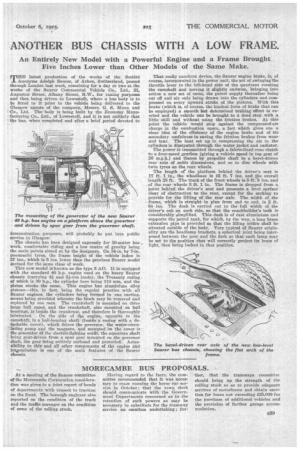ANOTHER BUS CHASSIS WITH A LOW FRAME.
Page 23

If you've noticed an error in this article please click here to report it so we can fix it.
An Entirely New Model with a Powerful Engine and a Frame Brought Five Inches Lower than Other Models of the Same Make.
TuLHE latest production of the works of the Saclike Anonyme Adolph Saurer, of Arbon, Switzerland, passed through London last week, remaining for a day or two at the works of the Saurer Commercial Vehicle Co., Ltd., 21, Augustus Street, Albany Street, N.W., for tuning purposes and then being driven to Lowestoft, where a bus body is to be fitted to it prior to the vehicle being delivered to the Glasgow agents of the company, Messrs. G. S. Munn and Co., Ltd. The body is being built by the Economy Manufacturing Co., Ltd., of Lowestoft, and it is not unlikely that the bus, when completed and after a brief period devoted to
demonstration purposes, will probably be put into public service in Glasgow.
The chassis has been designed expressly for 30-seater bus work, comfortable riding and a low centre of gravity being the main points aimed at by the designers. On 34-in. by 7-in. pneumatic tyres, the frame height of the vehicle laden is 27 ins., which is 5 ins, lower than the previous Saurer model devised for the same class of work.
This new model is known as the type 3 AD. It is equipped with the standard 40 h.p. engine used on the heavy Snorer chassis (carrying ft and 5i-ton loads), the Treasury rating of which is 20 h.p., the cylinder bore being 110 mm. and the piston stroke the same. This engine has aluminium alloy pistons—this, in fact, being the regular practice with all Sewer engines, the cylinders being formed in one casting, means being provided whereby the block may be removed and replaced by cue man. The crankshaft is mounted on three large ball races, and the crankshaft, also mounted on ball bearings, is Inside the crankcase, and therefore in thoroughly lubricated. On the side of the engine, epposite to the camshaft, is a ball-bearing shaft (inside a casing with a detachable cover), which drives the governor, the water-circu • lating pump and the magneto, and mounted on the cover is the generator of the electric-lighting outfit, the armature shaft being gear-driven from a spur gear mounted on the governor • shaft, the gear being entirely enclosed and protected. Accessibility to thin and all other cotnpouents of the engine and tra,psmission is one of the main features of the Saurer chassis.
That really excellent device, the Saurer engine brake, is, of course, incorporated in the power unit, the act of swinging the throttle lever to the left-hand side of the quadrant rotating the camshaft and moving it slightly endwise, bringing into action a new set of cams, the petrol supply thereafter being cut off and air only being drawn into the cylinders and compressed on every upward stroke of the pistons. With this brake (which is, of course, the kindest form of brake that can be employed) a smooth but determined braking effort is exerted and the vehicle can be brought to a dead stop with a little skill and without using the friction brakes. At this point the vehicle would stop against the compressed-air charge in the combustion space, a fact which gives one a clear idea of the efficiency of the engine brake and of its secondary usefulness in saving the friction brakes from wear and tear. The heat set up in compressing the air in the cylinders is dissipated through the water jacket and radiator.
The power is transmitted through a fabric-lined cone clutch to a four-speed gearbox (giving a vehicle speed in top gear of 26 m.p.h.) and thence by propeller shaft to a bevel-driven rear' axle of noble dimensions, and so to disc wheels with twin tyres on the rear wheels.
The length or the platform behind the driver's seat is 17 ft. 1 in., the wheelbase is 15 ft. 7 ins, and the overall length 25 ft. The track of the front wheels is 5 ft. 3 ins, and of the rear wheels 5 ft. 1. in. The frame is dropped from a point behind the driver's seat and presents a level surface clear of obstruction to the rear, except for the arching to provide for the lifting of the rear axle. The width of the frame, which is straight in plan from end to end, is 2 ft. 91, ins. The dash is carried out to the fun width of the driver's cab on each side, so that the coachbuilder's task is considerably simplified. This dash is of cast aluminium and supports the petrol tank, for which, by the way, a long brass extension pipe is provided so that the filling orifice shall be situated outside of the body. Very typical of Saurer originality are the headlamp brackets, a spherical joint being interposed between the post and the fork so that each Tamp may be set to the position that will correctly project its beam of light, then being locked in that position.
































